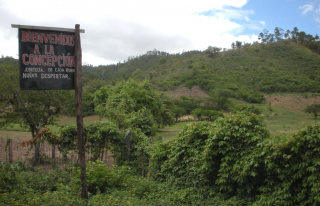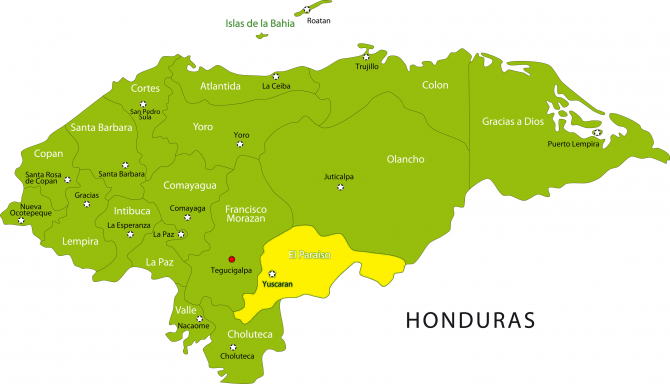La Concepción, Honduras
![]()
![]()
![]()
![]()
![]()
![]()
![]() Click on Programs to learn more about their work in this community
Click on Programs to learn more about their work in this community
General Information

| Population* | 580 |
| Number of homes |
165 |
| Avg # of people per home | 3.5 |
| Number and % of children | (0-14 years): 28% |
| Electricity | Yes |
| GPS |
N 13° 58.821’ W 086° 41.648’ |
| Altitude | 830m |
| Municipality | San Matías |
| Department | El Paraíso |
| Corresponding Health Center | CESAR-La Concepción |
| Distance from Compounds | 1.5 hours |
| Road conditions | Good |
* Population does not reflect how many patients will be seen on medical
brigades as many people from surrounding communities come seeking
Medical Brigades medical attention.
Top Three Needs Expressed
The top three needs expressed by the key community members are an expansion of the school, continual staff and medications for the health center and a source of obtaining or producing basic grains for better nutrition.

La Concepcion’s educational system includes Kinder and Primary schools (until 6th grade). There are many students in 7th-9th grade who stay in La Concepcion and receive their classes from local volunteers associated with the organization EDUCATODOS or the students of these grades travel to San Matías each day. There are 95 students at the schools in the community and Raquel Suarez is the school director. It is approximated that about 75% of the community knows how to read and write.
The water system in La Concepción consists of a pump installed over a well, followed by a pumping line which drives water the into the treatment tank. From there, the water is propelled by gravity to 120 houses, an elementary school, two churches, and a community bank. In an effort to conserve electricity (required to run the pump), the community makes water available every other day. The project was completed in June 2012.
La Concepcion has a rural health center in the community that had been closed and was just re-opened in March 2010. There is a basic sanitation committee with 3 active members. Dental care is not is available in the community.
The most common illnesses seen by community members are common cold, pharyngotonsilitis, diabetes, and blurred vision. Approximately 99% of the community has latrines that currently function. 90% has eco-stoves (estufas justas). About 40% is estimated to have cement floors and 60% to have pilas (water storage units).
Since the health center in La Concepción was just re-opened in March 2010, health statistics have not been kept for this community. Below are some health center statistics from the CESAMO-San Matías2 that had served La Concepcion during the interim period:
I. Caserios (small villages) served by CESAMO-San Matías, 2009
|
Caserios |
Population |
Potable Water (%) |
Latrines (%) |
Malnourished Children |
Births/ % Coverage of Pregnancies |
Order of Priority (based on HC standards) |
|
SAN MATÍAS* |
1290 |
82 |
70 |
11 |
21 / 95% |
3 |
|
Guayacan |
479 |
72 |
77 |
14 |
5 / 100% |
1 |
|
Agua Caliente |
280 |
86 |
94 |
4 |
3 / 100% |
4 |
|
Santa Rosa |
210 |
84 |
84 |
18 |
2 / 40% |
4 |
|
El Espinito |
462 |
92 |
99 |
5 |
7 / 70% |
4 |
|
Corral falso |
510 |
89 |
57 |
5 |
11 / 100% |
4 |
|
Robledal* |
628 |
86 |
85 |
14 |
7 / 47% |
2 |
|
San Francisco |
59 |
100 |
100 |
0 |
1 / 100% |
6 |
|
La Estancia |
114 |
100 |
100 |
29 |
1 / 50% |
5 |
|
Los Hoyos |
52 |
100 |
100 |
0 |
NA |
7 |
|
San Geronimo |
113 |
86 |
86 |
0 |
1 / 33% |
8 |
Centro de Salud Statistics, Centro de Salud Regional-Danlí, 14 Marzo 2010
*Global Brigades also works in these communities with medical brigades.
The average family income per month is estimated to be 1200 Lempiras, which is approximately L560 (US $29.65) per person3. The majority of homes are made of adobe, though there are some made of wood. The main forms of employment are in agriculture on owned land and the main products that are cultivated in the community are corn and beans. The problem with not having a tubed water system has negative implications for the ability to seed and maintain agriculture investments. La Concepcion does have access to credit from a community bank called “New Hope” (Nueva Esperanza) formed by PRODERCO in 1998, however this group is known for being a bit exclusive and only allows members (“socios”) to take out loans. The community could be interested in forming another community bank that would allow access to credit to any community member.
La Concepcion does not currently receive medical brigades from any other organization than Global Brigades. In 2003, World Vision has played a major role in this community, assisting with a water tank in 2003, latrine and pila projects in 2009, and continuing with their child sponsorship program as well as seeding fruit trees. FORCUENCAS also contributed to the fruit tree project and completed an eco-stove project in 2010.
La Concepcion is a medium-sized rural community that is 
fairly isolated from main highways. World Vision and FORCUENCAS have had a large presence in the community over the last 5 years. The people of La Concepción appear unified and collaborative, particularly the president of the town council.
|
Education |
11th |
|
Water |
5th |
|
Health |
80th |
|
Socio-economics |
39th |
|
Collaboration |
22nd |
|
Overall |
15th |
Total communities evaluated: 97
Source of information: Key informant interview, Centro de Salud statistics
Date of interview: 13 May 2010
1The accepted regulation frequency for chlorinating water is every 4 days.
2CESAMO and CESAR are terms used for types of health centers. CESAMOs are larger, more comprehensive facilities that usually have a physician on staff at all times and occasionally a dentist. CESARs are more remote, less equipped facilities, usually with 1-2 nurses on staff.
3According to Red Solidaria and World Food Programme in Honduras, the average family is approximated at 5 people per household, the poverty line is L930 (US$49.23) per person per month, and the extreme poverty line is L617 (US$32.66) per person per month.